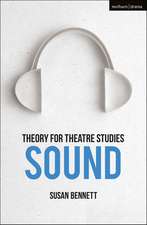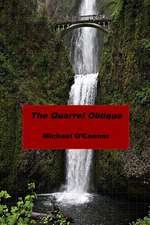Theory for Theatre Studies: Movement: Theory for Theatre Studies
Autor Rachel Fensham Kim Solga, Susan Bennetten Limba Engleză Paperback – 24 feb 2021
| Toate formatele și edițiile | Preț | Express |
|---|---|---|
| Paperback (1) | 112.93 lei 6-8 săpt. | +34.78 lei 4-10 zile |
| Bloomsbury Publishing – 24 feb 2021 | 112.93 lei 6-8 săpt. | +34.78 lei 4-10 zile |
| Hardback (1) | 343.48 lei 6-8 săpt. | |
| Bloomsbury Publishing – 24 feb 2021 | 343.48 lei 6-8 săpt. |
Preț: 112.93 lei
Preț vechi: 138.57 lei
-19% Nou
Puncte Express: 169
Preț estimativ în valută:
21.61€ • 22.48$ • 17.84£
21.61€ • 22.48$ • 17.84£
Carte tipărită la comandă
Livrare economică 14-28 aprilie
Livrare express 07-13 martie pentru 44.77 lei
Preluare comenzi: 021 569.72.76
Specificații
ISBN-13: 9781350026360
ISBN-10: 1350026360
Pagini: 208
Dimensiuni: 129 x 198 x 19 mm
Greutate: 0.24 kg
Editura: Bloomsbury Publishing
Colecția Methuen Drama
Seria Theory for Theatre Studies
Locul publicării:London, United Kingdom
ISBN-10: 1350026360
Pagini: 208
Dimensiuni: 129 x 198 x 19 mm
Greutate: 0.24 kg
Editura: Bloomsbury Publishing
Colecția Methuen Drama
Seria Theory for Theatre Studies
Locul publicării:London, United Kingdom
Caracteristici
It features elaborated case studies that can serve as a model for others' investigations of movement in theatrical production, live art and intermedial performance
Notă biografică
Rachel Fensham is Director of the Digital Studio at the University of Melbourne, Australia, where she is Professor of Theatre and Dance. Her key publications include To Watch Theatre: Essays in Genre and Corporeality (2009); and Dancing Naturally: Nature, Neo-Classicism and Modernity in Early Twentieth Century Dance (2011).
Cuprins
Series PrefaceAcknowledgementsMovement: IntroductionMovement of vital beings: AristotleMovement as bodily technique: MaussRhythmic movement: LefebvreCase Study: Pina BauschThis bookSECTION ONEMovement as HistoryMovement of the chorus: Ancient Greek theatreMovement of 'the flower': Noh aestheticsCase Study #1: Satoshi Miyagi's Antigone (2017)Gestural movement: Roman rhetoricCase Study #2: I Am My Own Wife (2003)Movement as style: The NatyasastraCase Study #3: Zero Degrees (2005)Processional movementHostility to movement: The anti-theatrical prejudiceRenaissance movement - from the vernacular to the cosmosCase Study #4: The Tempest (1611, 2016)Movement of the automatonCase Study #5: War Horse (2007)Conclusion SECTION TWOMovement Systems and Embodied ActionHolistic Systems: Craig, Delsarte and DalcrozeCase Study #1: Operation Orfeo (1993)Movement vitality: PhenomenologyMovement plasticity: Stanislavski and IbsenCase Study #2: Hedda Gabler (2005)Movement mechanics: MeyerholdCase Study #3, part a: The Constant Prince (1915)Movement dynamics: LabanMovement arrangement: BrechtCase Study #4: Mother Courage and Her Children (1949, 2006)Movement somatics: GrotowskiCase Study #3, part b: The Constant Prince (1965)Movement assemblage: ButohMovement Sociology: CrowdsConclusion SECTION THREEMovement in Contemporary TheatreSpeed: Attempts on Her Life (1997, 2007)Slowness: The Artist is Present (2010)Animation: Blackie Blackie Brown (2018)Force: World Factory (2014), Made in Bangladesh (2015) and World Factory (2016)ConclusionNotesReferencesFurther ReadingIndex
Recenzii
This book convincingly demonstrates why a focus on the kinaesthetics of theatre-and theatrical embodiment more generally-is as important as the study of dramatic writing, acting, and scenography. The author writes with considerable erudition about the topic, but in a way that is almost always immediately accessible.































